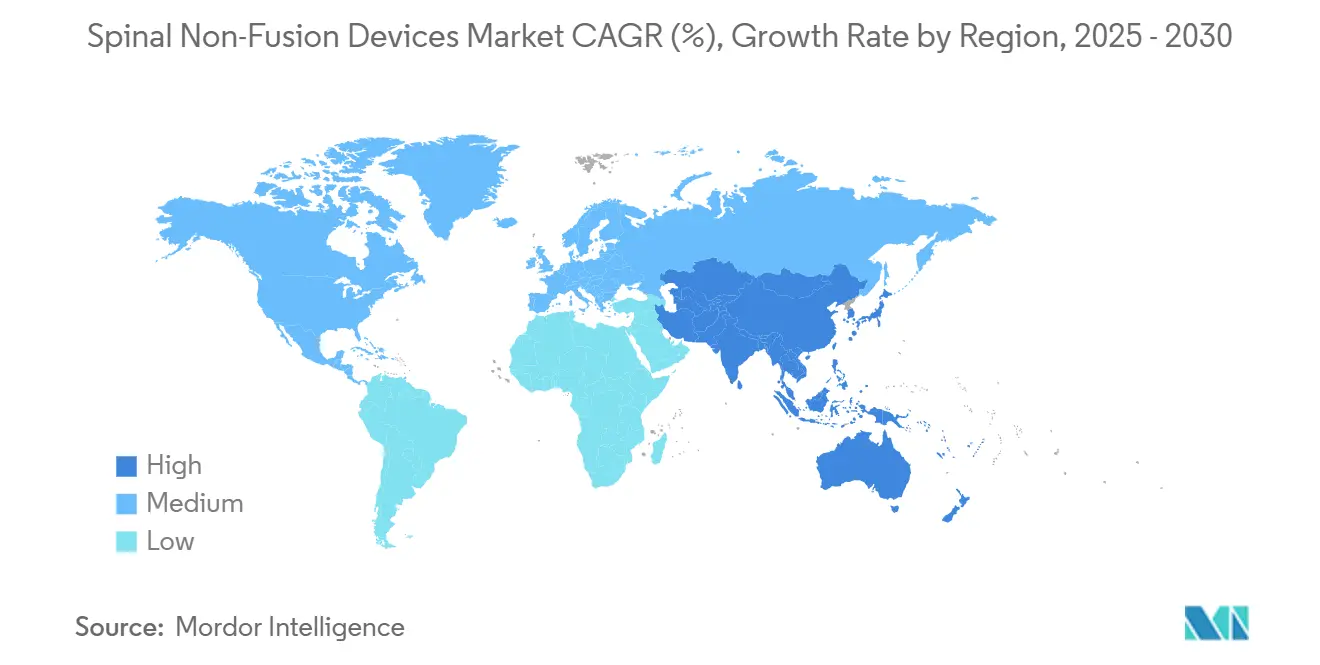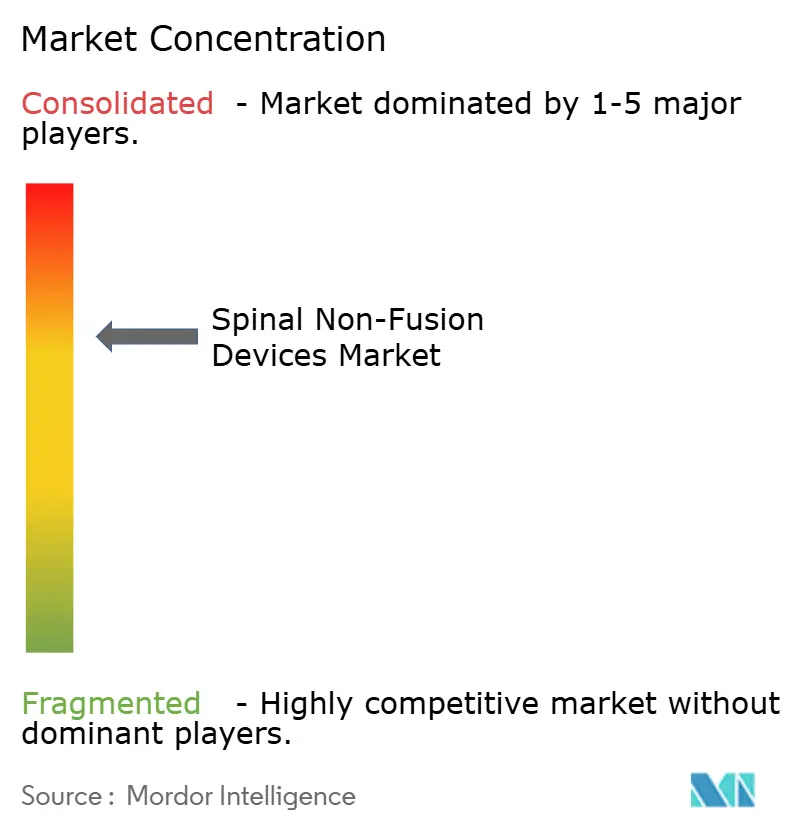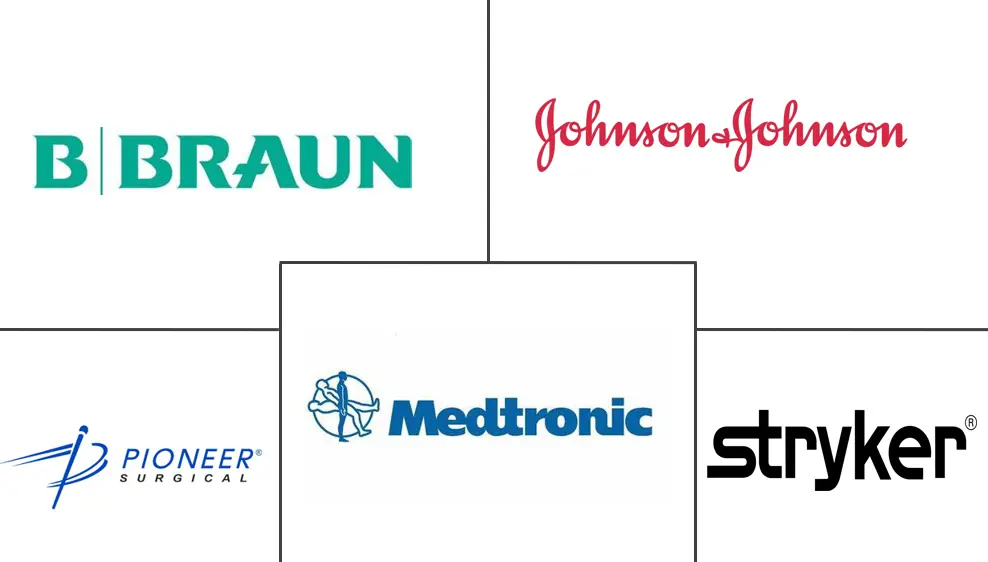Spinal Non-Fusion Devices Market Size and Share

Spinal Non-Fusion Devices Market Analysis by Mordor Intelligence
The spinal non-fusion devices market size is USD 3.85 billion in 2025 and is projected to reach USD 4.86 billion by 2030, expanding at a 4.76% CAGR. This measured trajectory reflects a decisive transition from experimental implants to validated motion-preservation technologies that address the long-term limitations of conventional fusion. Artificial intelligence now optimizes patient-specific implant geometry, streamlining pre-operative planning and cutting operating-room time, a shift that amplifies surgeon confidence in the spinal non-fusion devices market. North America currently anchors revenue, yet multi-layer policy reforms and infrastructure investment across Asia-Pacific are positioning that region as the next growth engine for the spinal non-fusion devices market. Hospitals remain the dominant purchasers, but ambulatory surgical centers (ASCs) are rapidly expanding demand as reimbursement policies move spine surgery to outpatient settings, reshaping procurement priorities throughout the spinal non-fusion devices market. Intensifying consolidation—illustrated by the Globus–NuVasive merger—confers scale advantages that accelerate development of AI-enabled surgical ecosystems, further redefining competitive dynamics within the spinal non-fusion devices market.
Key Report Takeaways
- By product category, artificial cervical discs held 35.19% of the spinal non-fusion devices market share in 2024, while nucleus and annulus repair implants are projected to expand at a 6.78% CAGR to 2030.
- By surgery type, minimally invasive procedures captured 65.34% of the spinal non-fusion devices market size in 2024 and are advancing at a 6.10% CAGR through 2030.
- By end user, hospitals controlled 58.82% revenue share in 2024, whereas ASCs posted the highest projected growth at 10.93% CAGR to 2030.
- By geography, North America led with 42.23% revenue in 2024; Asia-Pacific is set to grow at a 5.94% CAGR between 2025 and 2030.
Global Spinal Non-Fusion Devices Market Trends and Insights
Driver Impact Analysis
| Driver | (~) % Impact on CAGR Forecast | Geographic Relevance | Impact Timeline |
|---|---|---|---|
| Shift toward motion-preserving spinal surgeries | +1.2% | Global, with North America & Europe leading adoption | Medium term (2-4 years) |
| Rising prevalence of degenerative disc diseases | +0.8% | Global, with aging populations in developed markets | Long term (≥ 4 years) |
| Rapid adoption of minimally-invasive dynamic stabilizers | +1.0% | North America & APAC core, spill-over to Europe | Short term (≤ 2 years) |
| Reimbursement expansion for artificial disc replacement | +0.6% | North America & Europe, with selective APAC coverage | Medium term (2-4 years) |
| Growing venture funding for nucleus & annulus repair start-ups | +0.4% | North America & Europe innovation hubs | Long term (≥ 4 years) |
| AI-guided patient-specific implant design breakthroughs | +0.8% | Global, with early adoption in developed markets | Medium term (2-4 years) |
| Source: Mordor Intelligence | |||
Shift toward motion-preserving spinal surgeries
Clinical practice is moving decisively from fusion-first protocols to motion-preservation pathways. Prospective evidence shows anterior cervical hybrid constructs preserve 16.3° of segmental motion versus 4.7° in multilevel fusion, a functional edge that correlates with lower revision rates. Facet arthroplasty devices such as TOPS reported 93% patient satisfaction in FDA trials, reinforcing economic value despite higher up-front cost. Surgeon preference for physiologic kinematics is therefore translating into robust purchasing momentum across the spinal non-fusion devices market.
Rising prevalence of degenerative disc diseases
An aging global population is driving sustained procedural volume, with Medicare data predicting significant expansion in spinal instrumentation demand through 2050. Earlier imaging-driven diagnosis favors motion-preserving interventions before irreversible damage, enlarging the spinal non-fusion devices market. Younger cohorts also value implants that minimize the need for later revision, intensifying long-run demand.
Rapid adoption of minimally invasive dynamic stabilizers
Robotics-guided navigation achieves 96.99% pedicle-screw accuracy, cutting peri-operative risk and lowering learning curves for dynamic stabilization[1]Source: Oh B-K et al., “Robotic-Assisted Spine Surgery Accuracy,” e-neurospine.org . Nitinol spring rods deliver a 16.9% adjacent segment disease rate over 13 years, outperforming rigid fixation and bolstering uptake in the spinal non-fusion devices market. The synergy of robotics and flexible hardware supports premium pricing and broader surgeon adoption.
Reimbursement expansion for artificial disc replacement
Medicare and private payors are broadening coverage for cervical disc replacement, with local coverage determinations reclassifying the procedure from experimental to medically necessary for defined indications[2]Source: Centers for Medicare & Medicaid Services, “LCD – Cervical Fusion,” cms.gov . Cost-effectiveness models show lower cumulative expenditure versus fusion, which accelerates adoption across the motion preservation devices market. Lumbar coverage lags but is trending upward as additional trial data become available.
Restraint Impact Analysis
| Restraint | (~) % Impact on CAGR Forecast | Geographic Relevance | Impact Timeline |
|---|---|---|---|
| High device cost & limited hospital budgets | -1.8% | Global, with acute pressure in emerging markets | Short term (≤ 2 years) |
| Stringent multi-region regulatory approval timelines | -0.9% | Global, with varying regional complexity | Medium term (2-4 years) |
| Payer reluctance toward lumbar disc replacement reimbursement | -0.7% | North America & Europe primarily | Medium term (2-4 years) |
| Supply-chain dependence on specialty Nitinol alloys | -0.6% | Global manufacturing networks | Short term (≤ 2 years) |
| Source: Mordor Intelligence | |||
High device cost & limited hospital budgets
Hospitals face 20% jumps in shipping, labor and raw-material expenses, leading to tighter capital allocation that slows premium implant adoption. France’s reimbursement cuts for orthopedic hardware underscore mounting price pressure, dampening near-term volume in the spinal non-fusion devices market.
Stringent multi-region regulatory approval timelines
Regulators require expansive trial evidence across diverse cohorts. The HYDRAFIL pivotal study exemplifies the multi-year pathway facing novel regenerative implants, delaying market entry for small innovators . Prolonged timelines elevate development expense, curbing agility in the spinal non-fusion devices market.
Segment Analysis
By Product: Cervical Dominance Meets Regenerative Innovation
Artificial cervical discs captured 35.19% revenue in 2024 and remain the anchor of the spinal non-fusion devices market. Long-term data on Mobi-C show lower adjacent-segment pathology compared with fusion, reinforcing surgeon preference. The spinal non-fusion devices market size for artificial cervical discs stood at USD 1.35 billion in 2024 and is expanding steadily at a mid-single-digit rate.
Nucleus and annulus repair implants are on track for a 6.78% CAGR through 2030, reflecting regenerative-medicine traction and growing funding. Their share of the spinal non-fusion devices market size is set to rise as clinical trials confirm sustained disc-height restoration. Dynamic stabilization systems hold notable share through biomechanical superiority, whereas interspinous spacers lag amid mixed coverage decisions. Facet joint replacements and other emerging devices contribute incrementally but hold long-run upside as evidence builds.

Note: Segment shares of all individual segments available upon report purchase
By Surgery Type: Minimally Invasive Procedures Accelerate
Minimally invasive surgery held 65.34% of the spinal non-fusion devices market size in 2024 and is forecast at a 6.10% CAGR owing to robotics-guided workflows that minimize collateral tissue damage. Navigation systems that cut radiation exposure reinforce the safety narrative and boost surgeon comfort, catalyzing broader use across routine cases.
Open procedures retain importance for complex deformity corrections but will continue ceding share. Device makers are redesigning implants for faster placement and same-day discharge, capabilities now essential for winning in the spinal non-fusion devices market.
By End User: ASC Growth Reshapes Delivery Models
Hospitals controlled 58.82% of 2024 revenue because they handle multi-level pathologies and trauma requiring hybrid constructs. Their volume guarantees baseline demand across the spinal non-fusion devices market.
ASCs, however, are growing at a 10.93% CAGR as payors shift appropriate procedures to outpatient settings, boosting throughput for motion-preserving implants. Specialized spine clinics embedded in the ASC channel are turning into preference centers for premium non-fusion devices, influencing future product development and marketing strategies.

Note: Segment shares of all individual segments available upon report purchase
Geography Analysis
North America delivered 42.23% revenue in 2024 on the back of mature reimbursement and high surgeon training density. FDA clearances, such as the VELYS Spine platform, highlight continual integration of implants with navigation and robotics ecosystems. Coverage refinements around cervical disc replacement further secure volume growth, keeping the spinal non-fusion devices market buoyant.
Asia-Pacific is poised for the fastest regional CAGR of 5.94% through 2030, propelled by demographic aging and infrastructure upgrades. China’s streamlined device-registration catalogue accelerates time-to-market, enlarging the spinal non-fusion devices market in a nation where hospital build-outs remain strong. Japan’s adoption of advanced robotics and its super-aged society create robust demand, though clinical-evidence expectations remain rigorous.
Europe faces intensified cost-containment but continues to drive steady, evidence-based uptake. CE pathways for regenerative implants demonstrate regulatory openness, yet national budget caps may slow early-stage adoption. South America and Middle East & Africa present long-term opportunities as private hospital chains invest in advanced spine suites, although current volumes remain modest due to affordability and workforce constraints.

Competitive Landscape
The spinal non-fusion devices market is moderately consolidated. Globus Medical’s post-merger revenue surge to USD 606.7 million in Q1 2024 underscores how scale unlocks synergies between implants, navigation and robotics. Stryker’s strategic exit from its legacy spine-implant business while retaining digital-surgery assets shows a pivot toward high-value platforms.
Incumbents are investing in nitinol supply chain control and AI-enhanced design, erecting high entry barriers. Venture-backed disruptors such as DiscGenics leverage regenerative-cell therapies and FDA RMAT designation to carve niches without direct hardware competition. Supply-chain volatility favors vertically integrated entities, and further mergers are anticipated as smaller firms struggle with rising regulatory-compliance costs.
Competitive strategy now centers on full-stack ecosystems that bundle implants, software, and robotic execution. Companies unable to assemble integrated offerings risk relegation to commodity tiers, narrowing margin headroom across the spinal non-fusion devices market.
Spinal Non-Fusion Devices Industry Leaders
-
Stryker Corporation
-
Zimmer Holdings Inc.
-
Johnson & Johnson
-
Medtronic PLC
-
B Braun Melsungen
- *Disclaimer: Major Players sorted in no particular order



Recent Industry Developments
- February 2025: Medtronic launched the CD Horizon ModuLeX spinal system within its AiBLE ecosystem, targeting deformity correction with modular screws and enhanced visualization.
- November 2024: Globus Medical launched the ExcelsiusHub Navigation System designed to enhance surgical precision in spinal procedures, expanding the company's robotic-assisted motion preservation capabilities following the NuVasive merger.
Global Spinal Non-Fusion Devices Market Report Scope
As per the scope of the report, spinal non-fusion devices are medical devices that are employed in the correction of anatomical surgical defects of the spine using a non-fusion approach. Spinal non-fusion devices are used by surgeons during surgery for the treatment of deformity, stabilization, and strengthening of the spine and for promoting fusion. The Spinal Non-Fusion Devices Market is segmented by Product (Artificial Disc Replacement, Dynamic Stabilization Devices, Annulus Repair Devices, Nuclear Disc Prostheses, and Other Products), End User (Hospitals, Orthopedic Centers, and Other End Users), and Geography (North America, Europe, Asia-Pacific, Middle East and Africa, and South America). The market report also covers the estimated market sizes and trends for 17 different countries across major regions, globally. The report offers the value (in USD million) for the above segments.
| Artificial Cervical Disc |
| Artificial Lumbar Disc |
| Dynamic Stabilization Devices (Pedicle Screw/Rod) |
| Interspinous Process Spacers |
| Facet Joint Replacement |
| Nucleus & Annulus Repair Implants |
| Other Motion-Preservation Devices |
| Hospitals |
| Ambulatory Surgical Centers |
| Specialty Spine Clinics |
| Open Spine Surgery |
| Minimally-Invasive Surgery |
| North America | United States |
| Canada | |
| Mexico | |
| Europe | Germany |
| United Kingdom | |
| France | |
| Italy | |
| Spain | |
| Rest of Europe | |
| Asia-Pacific | China |
| India | |
| Japan | |
| South Korea | |
| Australia | |
| Rest of Asia-Pacific | |
| South America | Brazil |
| Argentina | |
| Rest of South America | |
| Middle East and Africa | GCC |
| South Africa | |
| Rest of Middle East and Africa |
| By Product Type | Artificial Cervical Disc | |
| Artificial Lumbar Disc | ||
| Dynamic Stabilization Devices (Pedicle Screw/Rod) | ||
| Interspinous Process Spacers | ||
| Facet Joint Replacement | ||
| Nucleus & Annulus Repair Implants | ||
| Other Motion-Preservation Devices | ||
| By End User | Hospitals | |
| Ambulatory Surgical Centers | ||
| Specialty Spine Clinics | ||
| By Surgery Type | Open Spine Surgery | |
| Minimally-Invasive Surgery | ||
| By Geography | North America | United States |
| Canada | ||
| Mexico | ||
| Europe | Germany | |
| United Kingdom | ||
| France | ||
| Italy | ||
| Spain | ||
| Rest of Europe | ||
| Asia-Pacific | China | |
| India | ||
| Japan | ||
| South Korea | ||
| Australia | ||
| Rest of Asia-Pacific | ||
| South America | Brazil | |
| Argentina | ||
| Rest of South America | ||
| Middle East and Africa | GCC | |
| South Africa | ||
| Rest of Middle East and Africa | ||


Key Questions Answered in the Report
What is the current size and growth rate of the spinal non-fusion devices market?
The market stands at USD 3.85 billion in 2025 and is forecast to reach USD 4.86 billion by 2030, expanding at a 4.76% CAGR.
Which product dominates the spinal non-fusion devices market?
Artificial cervical discs lead with 35.19% revenue share, supported by well-documented clinical outcomes and solid reimbursement.
Why are ASCs significant for future device adoption?
ASCs are growing procedures at 10.93% CAGR to 2030 because payer policies favor outpatient spine surgery, increasing device turnover and shaping product design.
Which region presents the highest future growth opportunity?
Asia-Pacific is projected for the fastest CAGR at 5.94% due to demographic aging, regulatory harmonization, and expanding hospital infrastructure.
Page last updated on:








